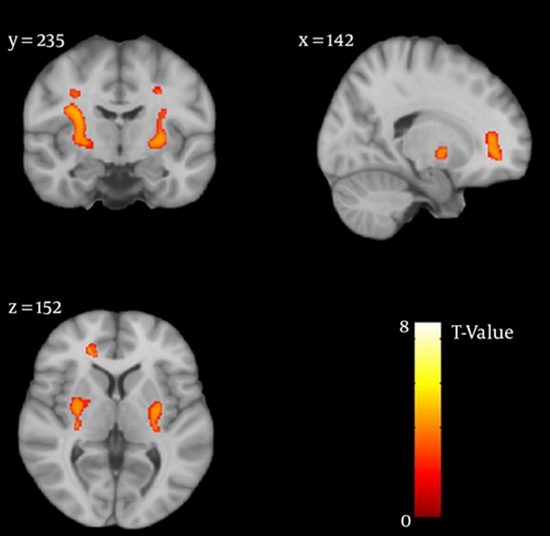Lower Gray Matter Density in the Anterior Cingulate Cortex and Putamen Can Be Traceable in Chronic Heroin Dependents After Over Three Months of Successful Abstinence

Background:
In recent years, a few studies have addressed the effect of chronic heroin use on brain structure with respect to volume and shape; however, the literature in this field is sparse and further studies are necessary to generate robust replications.Objectives:
In this study, we intended to assess gray matter density (GMD) differences between successfully abstinent heroin dependents and healthy subjects. Indirect evidences for the causal role of drug use in the GMD differences are also targeted here by testing the hypothesis on the correlation between GMD differences and duration of drug use.Patients and Methods:
Using structural magnetic resonance imaging (MRI) and voxel-based morphology (VBM) technique, changes in gray matter volume and density were evaluated in 18 abstinent heroin dependents and 20 age-, education- and gender-matched healthy subjects. Heroin dependents were all male, and at least 3 months successfully abstinent (mean abstinence duration = 9.2 ± 5.2 months).Results:
Decreased GMD in the right anterior cingulate cortex and bilateral putamen were found in abstinent heroin dependents in comparison to controls, corrected for multiple comparisons (P < 0.05). Also, partial correlation analysis, corrected for age, showed negative correlations between total intracranial volume (TIV) and total GMD (r = -0.61 and -0.44, respectively) with the duration of opiate usage in heroin dependents. GMD in the right putamen also had negative correlation with the duration of drug abuse (r = -0.49) and a weak negative correlation was observed between left putamen density and duration of drug abuse (r = -0.42). Examination of the negative correlation between the duration of drug abuse before the age of 25 years and total GMD, while controlling for age, showed weak negative results (r = - 0.44).Conclusion:
Specific structural changes were noticeable in prefrontal and striatal areas in the heroin dependents even after a period of successful abstinence. Our results on the interaction between duration of drug use and some of these structural changes provides preliminary ideas for reciprocal cause and effect roles for brain structural changes and heroin abuse. These findings might also imply that brain structures are unable to return to normal state and cannot recover spontaneously even after months of abstinence. This evidence reminds us of the importance of neurorehabilitation interventions after termination of drug use






ارسال به دوستان